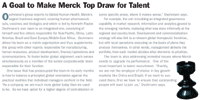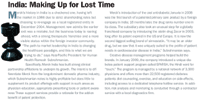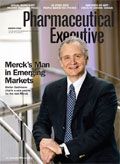The New Merck's Move on Emerging Markets
Can the combination with Schering-Plough transform the company from an also-ran to a contender in the big push for market share in the developing world?
Success in today's fast-moving pharma business may be as intuitive as choosing the right brood mare for a future day in the winner's circle. If so, then Stefan Oschmann, the 52-year-old German-born, veterinarian-degreed horse racing fan tagged to lead Merck's new business unit for emerging countries, has the background to build a thoroughbred franchise. Handed the slot in November after two decades moving up the ranks to head legacy Merck's European operations, Oschmann's new role is pivotal to the merged company's "triple crown" strategy for long-term organic growth. This includes, in addition to emerging countries, a big stake in biologics and vaccines, which are critical to expanding the customer base in medically underserved, high potential markets like China, Brazil, and India—home to 40 percent of the world's population.

Getty images / Robert Kohlhuber
Merck is the proverbial dark horse in the race for dominance in emerging markets, starting from a low base compared to the biggest players in the field. Even with the acquired strength of Schering-Plough's diverse international businesses, the new Merck ranks fifth in size—behind leaders Sanofi, Pfizer, Novartis, and GSK, respectively—with a modest 3 percent market share for medicines in the 17 countries designated by the IMS Midas data base as "pharmerging."
"Size and scale is critical to managing the complexity of competition in these diverse markets, so considerable resource commitments will be required for the new Merck to deliver on the potential it sees from them," IMS Health SVP Murray Aitken told Pharm Exec. Expanded global reach, beyond the company's traditional focus on the slowing US market, was a key driver for the merger with Schering-Plough, CEO Dick Clark said to analysts posing the same thought at the annual earnings call on February 16. He noted that $3.5 billion in cost cuts scheduled through 2012 will create new opportunities to reallocate resources toward these countries, under an "invest to grow" strategy linked to the deployment of an expanded portfolio of vaccines, OTCs, mature products, follow-on biologics and patented biologics, all focused on serving local unmet medical need.

Stefan Oschmann
Nevertheless, executing this change poses its own set of challenges, especially as the distractions of a CEO succession search get underway later this year.
Emerging or Arrived?
To Oschmann, progress in building market share follows logically from defining market reach, with the latter based on establishing who the customer is, how best to serve his needs, and delivering results in real time against the competition. His conceptual vision is startlingly simple. Emerging markets are individually distinct but do share two basic characteristics: rapid economic growth and significant unmet medical need. Competitive advantage will fall to those companies who can respond to this mix of wealth and want with skills that prioritize flexibility, in a fluid, highly-charged business cycle; and speed, at a pace that matches patient aspirations for new therapies and better, high-quality care.

A Goal to Make Merck Top Draw for Talent
"Merck has invested heavily in a more customer-centric business model, but we understand that can mean different things in different markets," Oschmann says. "In emerging countries, how well we execute locally is fundamental to our philosophy and to business success."
Metric for Success
Oschmann explains that Merck's strategy for this important geography is still a work in progress. The company will proceed at a deliberate pace to capitalize on lessons derived from Schering-Plough's extensive exposure in developing countries, where many of the acquired company's key country managers have been retained, as well as from the practices of leading competitors. The basic metric for success is ambitious: to achieve revenue growth at a rate that matches or exceeds the underlying expansion of the markets where Merck chooses to engage.

Ramesh Subrahmanian
This does not imply the approach is entirely ad hoc—Oschmann and his management team are committed to a set of business fundamentals that will shape daily decisions taken in the field.
First is to build the business as a reliable, high-quality source of customer-focused product and service solutions. The root objective is put product in the service of outcomes, and to raise the standard of care in line with rising incomes, based on an assessment of where Merck's portfolio can best address the prevalent health challenges of each market. It is a combined business and societal objective, where the "quality product" brand underpins the larger corporate reputation, which is in turn critical to retaining the confidence of government and other powerful emerging market stakeholders.
Says Ramesh Subrahmanian, Merck's President for Human Health in the Asia-Pacific Region, "we're not just blanketing the markets with pills that we sell indiscriminately. Instead, the goal is to carefully differentiate our portfolio from the competition by following the patient into unmet areas of medical need."

Boris Braun
"Across the Board" Innovation
The distinctive contrasts and challenges of doing business in emerging markets can lead to new ways to innovate. Here, the emphasis is on the processes and platforms by which medicines and adjacent health technologies are developed, packaged, priced, promoted, manufactured and distributed. Long term, Merck believes that success in these still-developing states will drive business models in the US and Europe, for example by creating a better understanding of how rival companies compete in growth segments like branded generics and follow-on biologics.
"What's exciting about this assignment is that emerging countries are not living under the health management approaches adopted in the mature markets during the last century," says Oschmann. "There is room for experimentation. Of course, there is potential for reducing costs, but we are investing for the return we see from these countries acting as a springboard for innovation—new commercial opportunities that can ultimately be applied anywhere."

India: Making Up for Lost Time
One place where Merck is exploring new supply and delivery platforms is rural India, which accounts for about a fifth of the total market, but is almost totally ignored by the local generic industry—hence an opportunity for big pharma if it can get the product mix, pricing and distribution right. "And don't we have a similar problem here in rural North America?" asks Oschmann
One way Merck may single itself out from the competition is to maintain this focus on innovation—all through the supply chain. "Creating novel service approaches to backstop the provision of medicines is a key differentiator of value in emerging markets. We intend to do that with our offerings."
It also requires addressing the level of resources management wants to commit to conducting R&D and related clinical activities in high-growth places like China and India. Other companies are ahead of Merck here, which has opted for the "virtual engagement" approach as opposed to building dedicated brick and mortar facilities. The company is reevaluating options to invest as part of the current global restructuring of R&D activities, under which emerging markets are likely to get a larger share of the pie.
Parsing the Off-Patent Label
The team is still looking carefully at how best to position Merck in the established off-patent small-molecule segment, particularly as Sanofi and others have big footprints there. "We want to continue to be seen as a sponsor of real innovation. So our approach has to be selective." At any rate, Oschmann believes that for emerging markets the distinction between patent and off-patent is an artificial one, for two reasons: the supply chain doesn't differentiate, with wholesalers and pharmacists handling a broad range of product in the same way; and physicians and patients care less about patent status than the reputation for quality associated with the corporate logo—"our MSD name is the best brand identifier," he contends.
A logical path from this quality metric is to seize the potential of follow-on biologics, a segment where Merck has already made commitments to secure market leadership in the US but where there is potential in sourcing targets in developing countries as well.
Pitch-Perfect Portfolio
The second element to capitalize on is the strength of the broader portfolio of products created by the combined companies. A no-brainer is a more substantial emphasis on vaccines. Though challenged now by Pfizer with its Prevnar 13 blockbuster, Merck still holds a global leadership position in vaccines for pediatrics; one where the birth cohort for China and India alone—an indicator of potential market size—is larger than the rest of the world combined. Likewise, due to slow buildup and some pricing uncertainties the company has yet to tap a fraction of the local potential for Gardasil in preventing cervical cancer, estimated by the WHO as the leading cause of cancer deaths for women in developing countries.
A rich vein also exists in the OTC retail business, where Merck can build on Schering's consumer portfolio in key regions like Latin America and the Middle East. At present, the business amounts to a mere 3 percent of the combined company's worldwide sales, but the perceived opportunity from OTC as a platform for growth in the emerging markets means that divesting it is not an option, despite the heavy competition from established big pharma players like J&J.
The appeal of the consumer business is doubled by the fact that in many, if not most, emerging markets, consumers are used to paying from their own pocket for health care and now have more discretionary income to spend. There are also strong complementarities with Merck's presence in prescription-based endocrine/women's health therapies.
Last, but certainly not least, is the goal of seizing opportunities from Merck's inventory of patented innovative products geared to the treatment of chronic disease. This includes therapies for diabetes, cardiovascular disease, hypertension, asthma, and inflammatory disorders. Three quarters of the estimated 250 million people with diabetes live in the developing world.
"Arguably few other big pharma companies have an inventory of existing small molecule medicines better suited to fit the primary care health challenges of these countries," Albert Wertheimer, director for health services research at Temple University, told Pharm Exec. He sees a big potential for tie-in with cost-effective prevention strategies that benefit emerging markets because they substitute for acute care services that many patients cannot afford.
Position on Pricing for the Poor
Oschmann says the company is studying how to link its portfolio offerings to a new affordable pricing model that will increase access. "Neglected populations in emerging markets are a commercial opportunity. It's wrong to see it as an isolated group of poor individuals because the communities that the poor live in are sizeable and collectively they have real assets to buy better health care."
The company is looking at new, low cost options to the provision of its small molecule drugs and vaccines geared to this "bottom of the pyramid" consumer segment. It is committed to working with governments as well, evidenced by management's decision to be one of the few foreign companies to tender as supplier to China's new Essential Drug List (EDL) of low-cost medicines. A former Schering-Plough facility in Mexico is also being recast to consider new medicines formulations to suit the specialized needs of purchasers in emerging markets. Work will be conducted in tandem with the search for efficiencies in manufacturing and the supply chain.
Positioning for Partner of Choice
The third strategic driver follows logically from this: building bold partnerships. "We were first in the industry here, launching the Mectizan program against river blindness way back in 1987. Partnering around innovation is ingrained in the Merck business culture," Oschmann says. Done right, partnerships can yield a marketing advantage by building awareness of disease states where traditional metrics do not exist. It is also valuable to accessing the customer base because in many emerging countries traditional sales and distribution channels are weak or ill defined.
More important, a bias toward local industry means that two-way partnerships are vital to convincing governments that the company is committed to the country as a responsible investor. Merck has tried to take a higher profile than other companies in shaping the policy debate in emerging markets, sponsoring a series of workshops on medicines access and affordability issues in Turkey and Poland. On good will grounds alone, this activity will continue.
One example of leadership in partnering is the joint venture Merck signed in September 2009 with the UK's Wellcome Trust. The mission is to develop and commercialize vaccines that address diseases in the developing world, and improve access to existing vaccines. This marks the first time a charity foundation and a pharma company have joined to create a separate business based on shared funding and investment decision-making rights. The JV's product stream will play a key role in advancing the emerging market group's strategy to bring more Merck vaccines to patients, at affordable prices.
One lesson Merck has learned from experience is that partnerships are most effective when they relate to local priorities. Says MSD Russia Managing Director Boris Braun, "in Russia, transparency is the transcendent issue of concern." This is why we are building collaborative partnerships to focus on clinical research, working with others to register substantive pools of eligible patients; supporting a centralized health system coordination to allow for unified site certification by local government; and sponsoring a number of sites to specialize in earlier stage and basic research in key areas of unmet medical need like oncology and psychiatry." The affiliate is also working with the Russian Rheumatology Society to build a national registry of patient data to monitor the condition of patients with immunological disorders, which can in turn serve as the basis for evidence-based treatment guidelines.
The End Game: Resolve and Resources
Integrating these three strands of strategy—product and process innovation, locally tailored portfolio offerings, and bold partnerships—is the next step for the new Merck's effort to rationalize its approach to emerging markets. Moving forward, the company can rely on the additives in terms of international exposure and capabilities made available through the Schering-Plough combination. But the integration process can itself induce "commitment fatigue," particularly as the company prepares for another round of downsizing to compensate for the patent cliff and a reduced cash position created by merger-related costs, as well as supporting efforts to shore up the global product portfolio against competition in increasingly crowded therapeutic segments. The company also is committed to ambitious sales growth targets in mature markets where it has some holes, especially Japan. Continued backing from new CEO leadership due in 2011 counts too.
More important, competitive challenges in the emerging markets are set to increase as these economies recover from recession and the gap between revenue prospects in the biggest emerging markets and the mature markets of the US and Europe grow more stark. Latest IMS data shows that the "pharmerging 17" countries contributed 37 percent of the global growth in pharmaceuticals in 2009. IMS predicts these countries are "set to overturn the established pharmaceutical world order" by accounting for 48 percent of the global growth by 2013. This space will become increasingly expensive as companies vie for competitive advantage. Starting from a lower base in the regions implies a significant resource investment by Merck to keep up with the blistering pace of change—will the money follow?
The Misinformation Maze: Navigating Public Health in the Digital Age
March 11th 2025Jennifer Butler, chief commercial officer of Pleio, discusses misinformation's threat to public health, where patients are turning for trustworthy health information, the industry's pivot to peer-to-patient strategies to educate patients, and more.
Navigating Distrust: Pharma in the Age of Social Media
February 18th 2025Ian Baer, Founder and CEO of Sooth, discusses how the growing distrust in social media will impact industry marketing strategies and the relationships between pharmaceutical companies and the patients they aim to serve. He also explains dark social, how to combat misinformation, closing the trust gap, and more.
Applying Porter’s Five Forces to Portfolio Management in Pharmaceutical R&D: A Strategic Roadmap
March 17th 2025The increasing costs and complexity of R&D in the pharmaceutical industry have necessitated the adoption of strategic portfolio management to optimize resource allocation and enhance competitive advantage.
